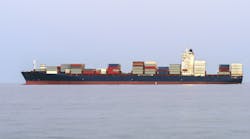Dreamstime
At the nation’s major container ports, import cargo volume is expected to hit the 2 million Twenty-Foot Equivalent Unit mark for the second month in a row in September and remain there in October, according to the Global Port Tracker report released on Sept. 8 by the National Retail Federation and Hackett Associates.“These are strong numbers and a sign retailers are optimistic about the holiday season since they don’t import merchandise unless they think they can sell it,” NRF Vice President for Supply Chain and Customs Policy Jonathan Gold said in a statement. “The holiday season is now the top priority for everyone in the retail supply chain as merchants prepare for the rush of shoppers who will soon be buying gifts for friends and family. As the holidays approach, the recent ratification of the West Coast port labor agreement between the ILWU and PMA provides supply chain stability and certainty for retailers utilizing the West Coast ports.”
Meanwhile, a restriction on the maximum draft of ships passing through the Panama Canal imposed this summer after drought conditions resulted in lower water levels has not materialized into the threat some had feared. With many ships carrying less-than-capacity loads or returning empty containers, most have been able to comply with the restriction and those awaiting passage as of mid-August were expected to complete their voyages without delay, Hackett Associates Founder Ben Hackett said.
“We have closely followed conditions at the Panama Canal,” Hackett said. “It now appears, however, that the situation has had little impact on the retail supply chain and is unlikely to be a problem as we head into the peak shipping season.”U.S. ports covered by Global Port Tracker handled 1.91 million TEU – one 20-foot container or its equivalent – in July, the latest month for which final numbers are available. That was up 4.4% from June but down 12.4% year over year.Ports have not yet reported August numbers, but Global Port Tracker projected the month at 2 million TEU, down 11.4% year over year but the first month since October 2022 to reach the 2 million mark. September and October are also forecast at 2 million TEU each for a potential three-month streak. (The number would be a 1.8% year-over-year drop for September but a 0.1% year-over-year gain for October.) November is forecast at 1.96 million TEU, up 10.4% year over year, and December at 1.94 million TEU, up 12% year over year.Those numbers would bring 2023 to 22.3 million TEU, down 12.5% from last year. Imports for all of 2022 totaled 25.5 million TEU, down 1.2% from the annual record of 25.8 million TEU set in 2021.January 2024 is forecast at 1.91 million, TEU, up 5.4% to begin the new year.
Latest from Global Supply Chain
Latest from Global Supply Chain



